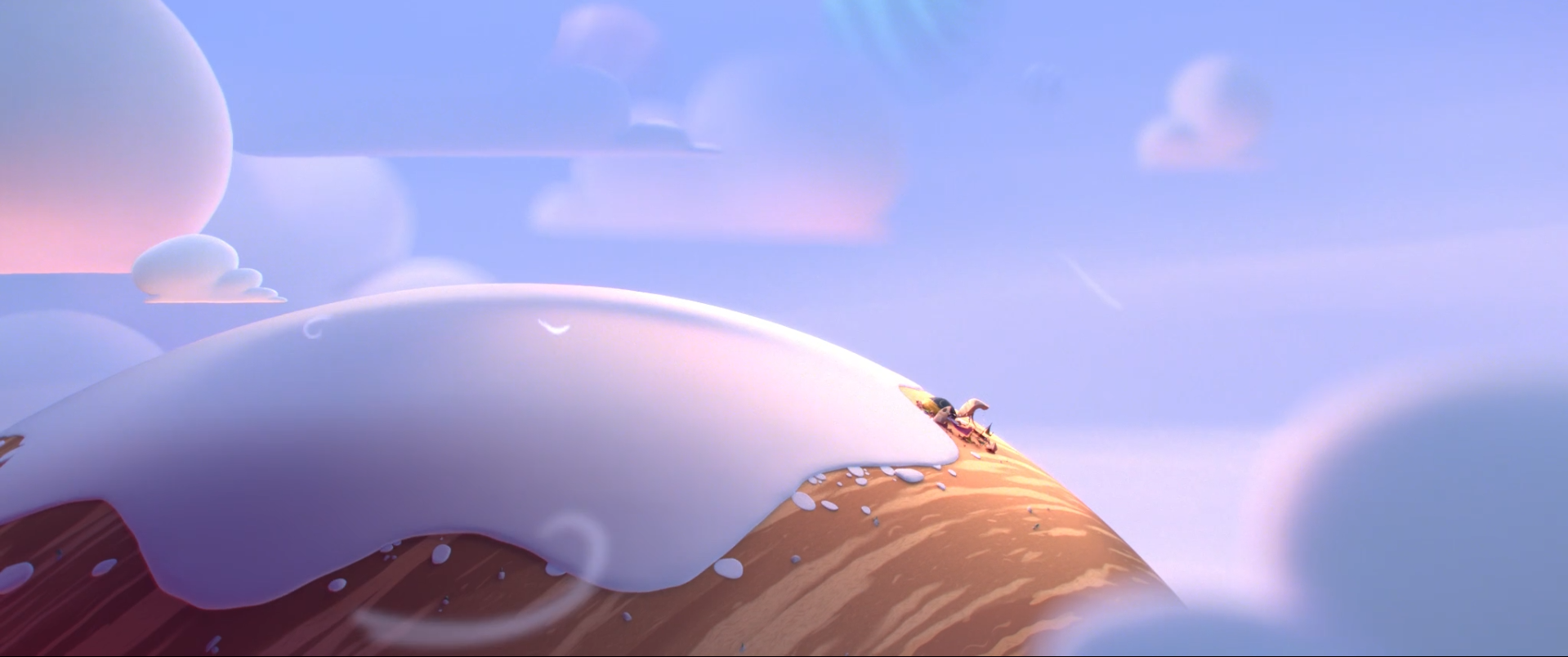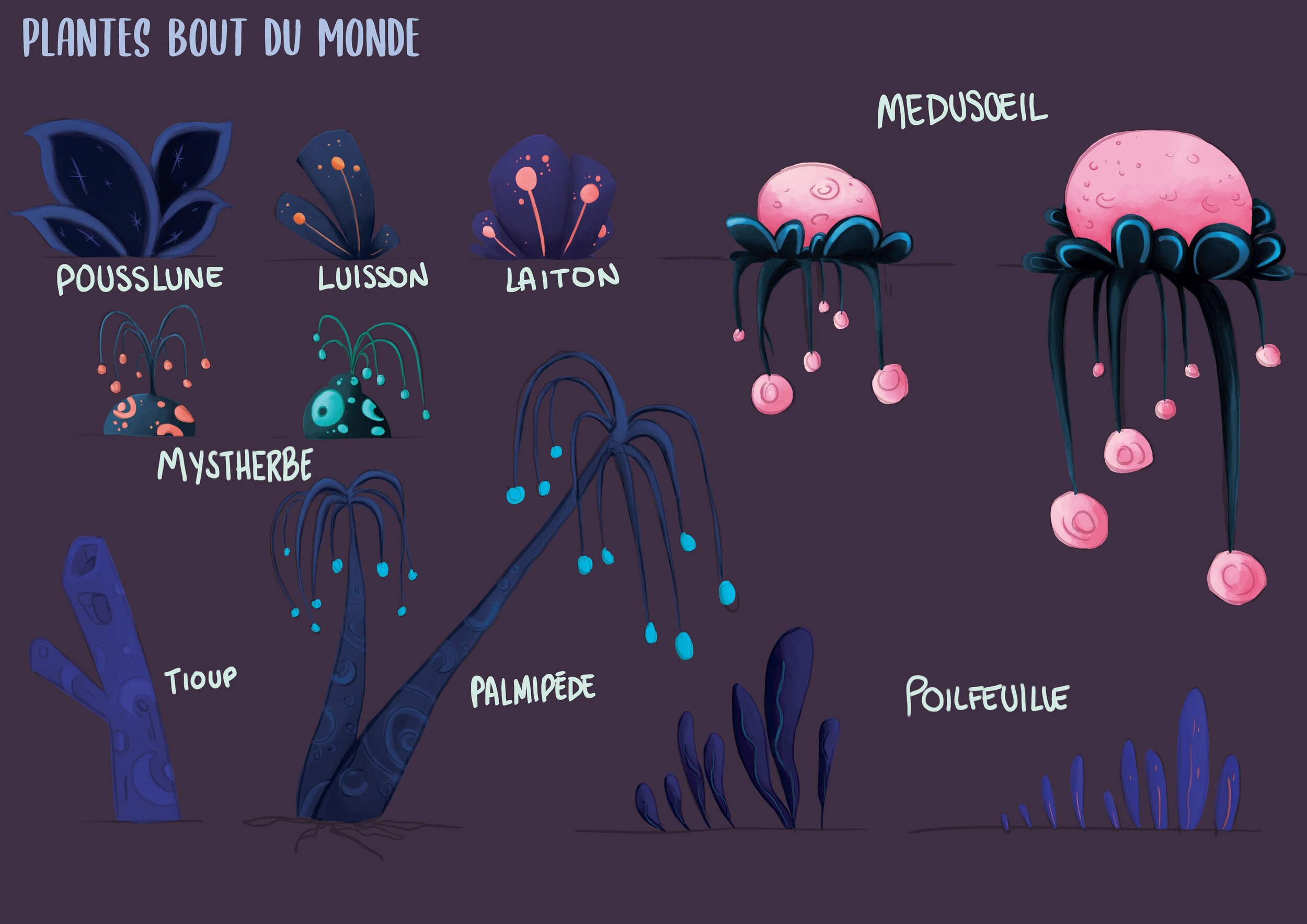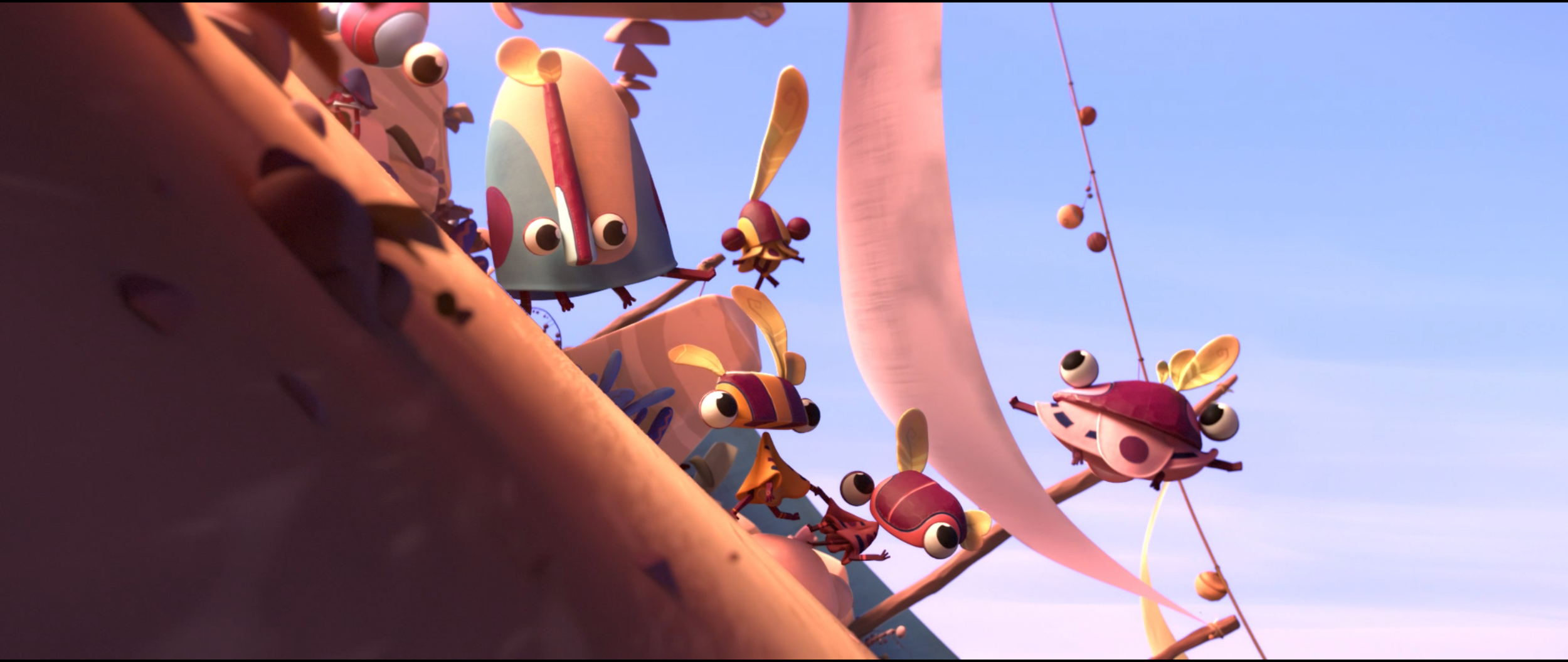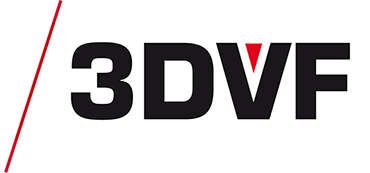This article is also available in:
French
3DVF: How did you create the snow? Was it more a technical challenge or an artistic one?
The idea of the snow popping came really fast, from discussions we had when talking about the story. For the animation, there were two types of shots: The close-ups, done with animated blendshapes to allow maximum control, and the large mountain shots done in Houdini. We had a clear idea of what we wanted, so it was mostly a matter of finding the right timing to create the feeling of randomness.
Concerning the way we approached the shading and rendering, we wanted it tangible, a bit realistic but still stylized, and also we needed the snow to react properly with its “popping” animation.

It was shaded procedurally, mostly using a mix of 2D and 3D fractal noises, and asked us to adapt its shader almost on a shot by shot basis. Often to find the right pattern and movement according to the camera distance, as the shader was animated to follow the mountain carrying it.
(A funny thing is that the snow and the clouds were using a shader almost identical; the clouds only losing the finesse of the ice covering the snow to lower their render weight.)

3DVF: The “big reveal” comes when the main character is at the edge of the world: the camera zooms out, and we realize that the world is a Space Giraffe floating in the void of space. Can you tell us about this scene from a storytelling perspective? And how hard was it to translate it in animation, to create a sense of wonder without ending up being just “weird” or “funny”?
It’s the heart of the film, the moment the spectator becomes omniscient. We hoped it would create a sense of wonder, but also compassion for this tiny naive being that traveled all this way alone. It was always a scene that excited us a lot!
To avoid the gag feeling, we tried to make the reveal as slow and smooth as possible, from the giraffe’s to the camera’s movement. We even explored the idea of rendering this part of the film in 48fps to bring an intangible fluidity to the scene. (But didn’t in the end)
The design of the giraffe was also a big part, she needed to be graceful, majestic, but also to belong to the universe. Which is why her legs or neck are “broken” just like Paccha-Picchu’s arms, for example.

3DVF: The music and sound design are key elements of your film, and they really help to make this world come alive. How did you approach this part of the project?
We had a clear idea of what we wanted for the music and sound design, very early on: we wanted Nicolas Jubert!!!
More seriously, he is the best friend to one of our team members so he was brought into the team at the beginning of the writing process. As we were writing, he was composing. As we were drawing, he was composing. As we were sleeping he still was composing. We think he was somehow trying to make us do a full-length picture! Therefore, the working process with him was very rich and exhausting, for both sides, we think.
It was a continuous back-and-forth, with music influencing design, or animation, or editing, and all those driving the music at the same time. It happened once or twice that we got lost in “what’s supposed to drive what”, especially with the timelapse sequence, which really depended on both the animatic editing and the music. We discovered quite a lot of instruments thanks to him and proceeded to decide which ones were working with the world and story, and the ones that were sounding a bit off.
Also, we think the precision of our retakes grew with time, as we all learnt (him included) what the world should sound like.
During the animatic and beginning of the production, he helped us define the sound of every element, and he was so much invested in the sound design process alongside the music that we had a clear difficulty separating them. For example, he designed the snow sound using a roll of toilet paper, and that worked so well! And more generally we were really attached to getting some natural and handmade sounds.
As we were having both Nicolas and Baptiste working on sound design, we decided that Baptiste would handle the sounds that were not directly needed for any music, and Nicolas would incorporate in his tracks the musical elements of the world.
So yeah, though he was not at school with us, he felt like a true team member from beginning to end. Once again, a huge thanks to him!

3DVF: The movie was rendered using RenderMan: How difficult was it to learn how to use it, and to give life to the lighting & rendering style you had in mind? By the way, can you give us some numbers about your render times?
We learned Renderman during the 4 years of school formation, and so the learning process was more a matter of time than of difficulty.
Just like all other renderers it has its pros and cons, it’s constantly evolving, and offers huge possibilities. Exhausting these possibilities would take way more than 4 years, that’s for sure. But in the end, it’s a tool like every other software and it allows for pretty much anything in terms of rendering style.
For us, its flexibility between physically accurate pictures and more artistically driven ones was a big help mostly thanks to all the light filters and blockers available. We wanted a tangible render, one that gives just enough realistic information to make the world credible, but also to be able to break or cheat the reality to bring up specific lines, shapes or shadows in the pictures.
The Teaser shots were the crash tests for that, to find the right tone, and find solutions to the first obvious problems we encountered.
One of them was the rendering of the snow; it was quite long to render! Depending on the shot (and the camera distance) the snow could take approximately from 1h to 5h to denoise properly. The subtlety and sharpness of the small ice crystals, when very close, were the most demanding. Indeed the denoiser would blur them out if there was too much noise remaining. For that, the most expensive shot of the film was the close-up near the end where KinKo grabs snow in its hands; that shot alone was at 10h/frame. Hopefully for us, the snow was the only expensive thing we had to render, and even though it’s a main element of the film, it was only present in 27 shots upon 103.
For the rest, the other shots took clearly less than 2h, a lot of them even taking less than 30mn. The Giraffe’s shots in particular were taking between 7 to 10mn.
3DVF: An unexpected challenge for the team was the pandemic. How did this affect your work?
Like many people we had to work separately during the pandemic. In order to stay organized and keep an eye on each other’s progress we used Discord. We discussed daily and often made calls to make decisions or solve problems. The same with the teaching team who also followed our progress on Ftrack.
It created some issues, especially to make sure everyone had every asset up to date and to make sure everyone worked with the same pipeline, as we had to manually download each file.
3DVF: What are you the most proud of, looking back at this project?
What we are most proud of is certainly the fact that the film is enjoyed by children and adults alike. We are also quite proud that we have created a universe from scratch that is consistent and awakens the curiosity of the spectators.

3DVF: Where have you been working since you left the school? Are you open to new opportunities?
After the film, the team split in a lot of different directions: Some went to Scotland, England, Canada, France… to work in various studios such as Hydralab, Nobody Studio, Untold Studios, Sony Pictures Imageworks, or Dwarf Animation Studio.
Adrien went on to work as a 3D animator on “Hotel Transylvania 4” at Sony Pictures Imageworks, “La Sirène” at StudioSoi, and now on “Kaeloo” at Cube Creative. Camille worked on various projects like “Partie de Campagne” at La Station Animation and advertising projects at Hydralab. Benjamin joined Nobody Studio in Montpellier where he’s still working as a Light/Comp Artist, mostly on short films and game cinematics. Pierre is working at DWARF Animation Studio as Junior Set Dressing. Briag went to London to work at Untold Studios as Rigger. Marianne worked for Armogaste as a Graphic Designer for a video game.
Camille and Marianne are both currently open to opportunities!

3DVF: Your short is “Oscar-Qualified”: how did you feel when you learned the news?
It was great news, of course! The film already went further than we could expect.
We are still rejoicing about its reception in the different festivals. The RiverRun award especially was a big surprise, and we feel so grateful to them. They were so nice and welcoming, and we really wish we could have physically attended their festival.
Qualifying for the Oscars is indeed a great honor and we are truly happy to be given this opportunity. We now only hope it will allow us to share this little story to more people.
For more information
- The official website;
- LinkedIn profiles of the directors: Camille Di Dio – Marianne Moisy – Briag Mallat – Benjamin François – Adrien Communier – Pierre Gorichon.


